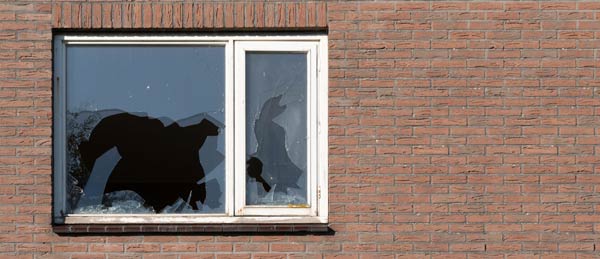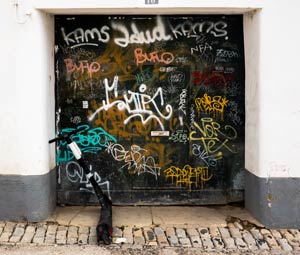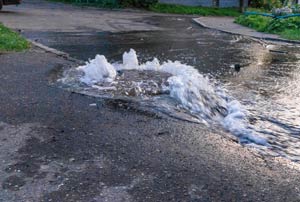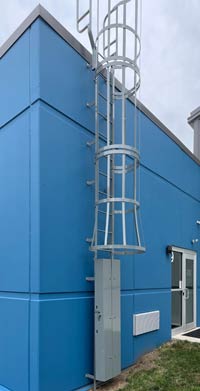
Preventing Vandalism and Off-season Damage
Those scenes in horror movies that portray teenagers entering abandoned houses or buildings can be a real-life horror for park districts facing seasonal closing of facilities. Unoccupied buildings are prime targets for vandalism and/or damage due to improper or incomplete off-season preparation. The key, according to Tim Jaskiewicz, PDRMA Risk Management Consultant, is to take a more strategic approach.
 These are some usual targets for this type of damage: These are some usual targets for this type of damage:
- Satellite maintenance buildings and vehicle storage areas.
- Restrooms, fieldhouses and historical sites.
- Miniature golf, concession stands, aquatics.
“Vandalism to property can be frustrating — and expensive — and reflect poorly on your agency’s public image,” he adds. “But preventive measures can be difficult to manage without help.”
Take a Strategic View
It’s important to take a strategic look at vandalism prevention and this five-step approach can help.
1. Build community relationships
“This is an important first step,” Jaskiewicz says. “Leverage your community assets and build partnerships by reaching out to local businesses, homeowners, law enforcement, community organizers and others to build awareness, share ideas, contribute resources and collaborate on crime prevention tactics.”
2. Gather and share information
Doing a deep dive to gather and share information, help target the problem and — very important — identify trends allows you to focus your resources. We suggest an action plan like this:
- Identify specific areas of your community, types of facilities and/or locations where vandalism is occurring and/or, due to various factors, has the potential to be a concern.
- Determine the types of property damage — graffiti, fires, broken windows, vehicles destroying turf, etc.
- Attempt to target timelines — dates and times that vandalism occurs and patterns of behavior.
- Days when school is not in session.
- Immediately after school dismissal.
- Specific days or a certain time range.
- Holidays.
3. Collaborate and prepare a response
Obtain information and work with internal and external partners/stakeholders to implement solutions. These could include:
- Increase/improve lighting, install timers on lights to provide an appearance of use, add protective covers to lights and/or install lighting in an out-of-reach location.
- Increase sight lines of facilities — trim/remove trees/shrubs.
- Move/house vehicles in secured areas such as garages and/or fenced yard areas.
- Consider making parts of a facility more difficult to access — trim trees adjacent to a building to minimize access to a roof, install fencing to protect vehicles or outside storage, secure external ladders and hatches.
- Develop a marketing campaign asking for your community’s help via a neighborhood watch program or a graffiti hotline.
- Take advantage of existing crime-stopper reward programs.
- Enact mandatory cleanup regulations across the community.
- If you are aware of time ranges, request additional patrols from local law enforcement during those times or contract with private security.
 4. Expand inspections and monitoring 4. Expand inspections and monitoring
Keeping an eye on your at-risk facilities can put bad actors on notice for vandalism and troubleshoot/fix off-season problems:
- Set up periodic inspections by staff and/or private security/police. Include both vandalism and best-practice property conservation observations ensuring:
- Drains are clear and downspouts are in place to minimize flooding.
- Heat works.
- Battery backup on sump pumps work.
- Debris such as rocks, pallets, sticks, etc., are not in the area and can’t serve as a tool for damaging property.
- Locks work and windows are secure.
- Outer facilities have alarms.
- Fencing/gates work.
 5. Try environmental design to prevent crime 5. Try environmental design to prevent crime
“Crime Prevention through Environmental Design (CPTED) is helpful to consider when planning construction or remodeling facilities,” Jaskiewicz explains. “You can also apply this concept to minimize incidents.”
- Access control.
- Can bollards, hedges, planters, gates and fencing minimize or make it more difficult for unwanted access by vehicles?
- Review access points to funnel activities to areas of intended use of the facility, such as maintaining clear paths to approved entrances.
- Promote intended use.
- Does the space look inviting to intended users such as dog walkers, joggers, tennis players or are paths cracked, nets torn, etc.?
- Would adding additional programming to a site attract and promote more users, reducing the likelihood of vandals?
- Surveillance.
- Maximize visibility from adjacent roads/buildings — trim shrubs/trees.
- Update/increase lighting in the area.
- Consider inspections and patrols.
- Maintenance.
- Show care of ownership, respond to maintenance concerns immediately.
- Consider the proactive use of building materials that are less likely to sustain damage — nonporous blocks on buildings, reinforced windows/doors/glass.
PDRMA Resources
|